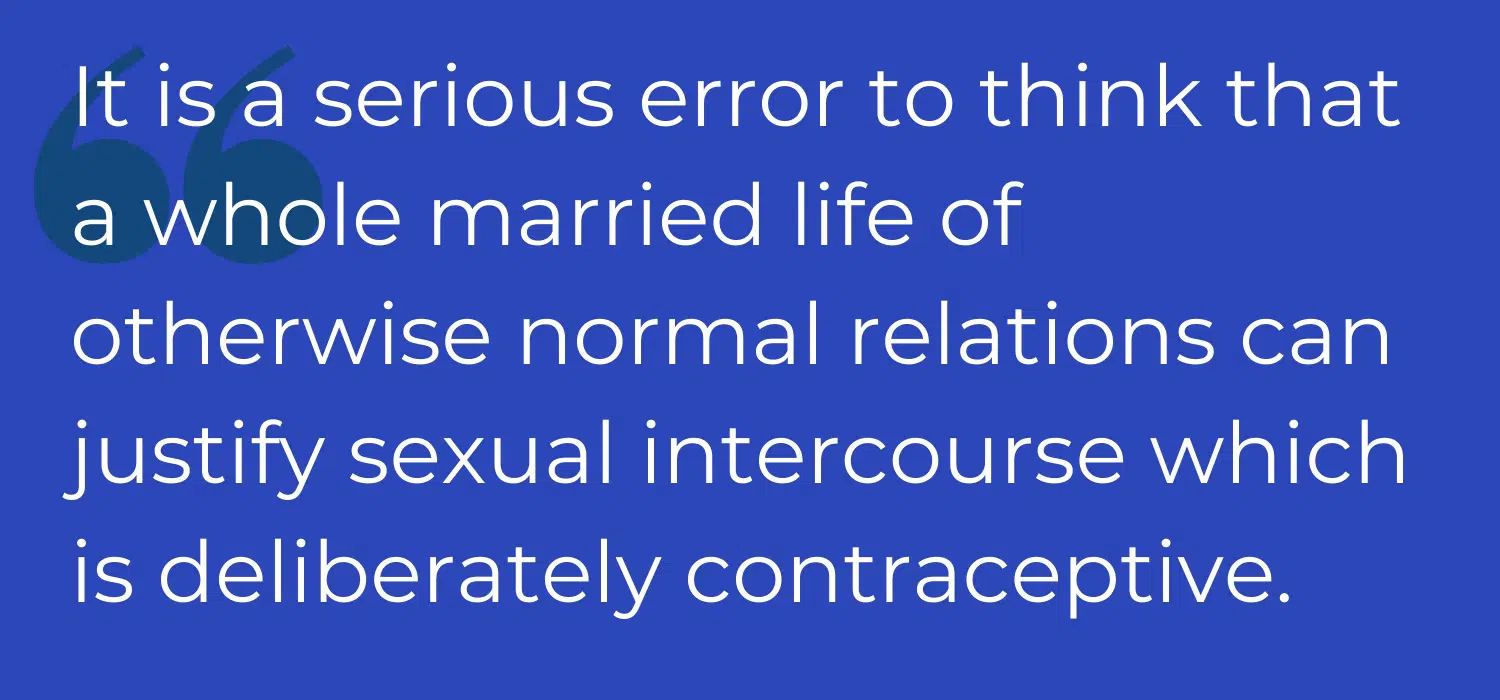Previous articles in this series:
- Part I: Introduction to Humanae Vitae
- Part II: The Predictions of Humanae Vitae
- Part III: The First Prophecy
- Part IV: The Second Prophecy
- Part V: The Third Prophecy
- Part VI: The Fourth Prophecy
- Part VII: Modernity’s Challenges to Humanae Vitae
- Part VIII: The Church’s Right to Teach on Birth Control
- Part IX: The Church’s Teaching Authority
- Part X: Principles of Humanae Vitae
- Part XI: The Moral Norm of Humanae Vitae
Later article in this series:
- Part XIII: Pastoral Guidelines
In our previous article we concluded our exposition of the moral norm of Humanae Vitae, which prohibits contraception as an intrinsically and gravely evil act. In this article we shall refute the main objections against the teachings of Humanae Vitae. These objections are:
- That there is a conflict between the values of procreation and conjugal love.
- That what matters is that the totality of the conjugal acts be open to life
- That NFP is the same as contraception.
- That Humanae Vitae is not in line with Vatican II.
Objection #1: “Procreation can conflict with conjugal love”
This objection stems from a fallacious argument of the “lesser evil.” It alleges that sometimes the values of openness to life and the expression of conjugal love are in conflict, and that this conflict has to be solved by putting those values in a balance in every situation. The married couple has to decide whether in a particular case the use of contraception in order to preserve conjugal unity is a lesser evil. Particular cases might be affected by economic, physical or psychological circumstances.
But we have already established that contraception is intrinsically and gravely evil. It does not make any sense to put an intrinsic evil on a balance with a value or good. Recall that an intrinsically evil act is an act that may never be performed, no matter what the circumstances or motives are.
In other words, this objection reduces the morality of the human act of contraception (and of any human act for that matter) to a balance of its consequences. It fails to consider the morality of the act itself. It does not follow the Catholic teaching about the threefold source of the morality of a human act (a free act): the intention, the circumstances, and the object of the act (i.e., the values inherent to the action itself). This is why this erroneous moral theory is called consequentialism or proportionalism. Many Catholic moral theologians have fallen into this serious error. That is why they reject Humanae Vitae’s teaching that contraception is an intrinsic evil.
Married couples who have serious reasons to postpone a pregnancy may recur to natural family planning (NFP), which is good in itself and is part of the natural law. Below we will refute the objection that claims that NFP is the same as contraception.
Objection #2: “What matters is that the totality of conjugal acts be open to life”
Proponents of this objection claim that it does not matter if the married couple contracepts in some of their sexual acts, provided the rest of such acts are open to life.
This objection is really silly. How can the totality of the conjugal acts be open to life if some of them are contraceptive acts? Besides, how does the couple determine how many of their sexual acts can be contraceptive acts while leaving the “totality” of their acts “open to life”?
This objection also fails to realize a very simple and evident fact: that the moral validity of each sexual act is not derived from the totality of such acts. It is the other way around: the moral validity of the totality of the sexual acts is derived from the moral validity of each sexual act. The totality is made up of the individual sexual acts and not the other way around.
Nevertheless, the main answer to this silly objection is, again, the fact that each contraceptive act is evil in itself. No “totality” of sexual acts “open to life” can justify a single contraceptive act. As Pope St. Paul VI himself said: “It is a serious error to think that a whole married life of otherwise normal relations can justify sexual intercourse which is deliberately contraceptive and so intrinsically wrong” (HV 14).
Objection #3: “NFP is the same as contraception”
Perhaps this is the most frequent objection against Humanae Vitae. It implies a very shallow understanding of the moral depth of the human act, and it attempts to place fundamentally different human acts at the same moral level. This way of thinking is typical of relativism, the erroneous “moral” theory that denies the existence of objective and universally binding moral norms.
NFP is far from being the same as contraception. NFP does not break the inseparable connection between the unitive meaning and the procreative meaning of the conjugal act, for the simple reason that it respects the original structure of the conjugal act as God designed it. After all, married couple are free to engage in their conjugal acts whenever they so choose, whether those acts are performed during the fertile or infertile phase of the wife’s menstrual cycle.
Contraception, on the other hand, deliberately breaks the inseparable connection between the unitive meaning and the procreative meaning of the conjugal act. It profoundly alters the original structure of the conjugal act and destroys its capacity to transmit human life. Moreover, experience has shown that when contraception fails, couples have the tendency to consider the pregnancy a “mistake” or worse still, they might even consider the unborn child an “intruder” in their sexual life, instead of God’s greatest gift to marriage.
As St. John Paul II wrote in his Apostolic Exhortation Familiaris Consortio:
In the light of the experience of many couples and of the data provided by the different human sciences, theological reflection is able to perceive and is called to study further the difference, both anthropological and moral, between contraception and recourse to the rhythm of the cycle: it is a difference which is much wider and deeper than is usually thought, one which involves in the final analysis two irreconcilable concepts of the human person and of human sexuality. The choice of the natural rhythms involves accepting the cycle of the person, that is the woman, and thereby accepting dialogue, reciprocal respect, shared responsibility and self- control. To accept the cycle and to enter into dialogue means to recognize both the spiritual and corporal character of conjugal communion and to live personal love with its requirement of fidelity. In this context the couple comes to experience how conjugal communion is enriched with those values of tenderness and affection which constitute the inner soul of human sexuality, in its physical dimension also. In this way sexuality is respected and promoted in its truly and fully human dimension and is never “used” as an “object” that, by breaking the personal unity of soul and body, strikes at God’s creation itself at the level of the deepest interaction of nature and person. (32)
We must understand that NFP is natural not because it does not involve any artificial device. After all, married couples can use computerized devices to help them detect the fertile and infertile phases of the woman’s cycle. NFP is natural because it conforms to human nature. Human nature has the unique characteristics of intellect and free will. NFP requires the use of both: the intellect to learn NFP methods (which are not difficult to learn, but do require some effort) and the will to exercise self-control by practicing periodic continence when the married couple has serious reasons to postpone their pregnancies. In fact, NFP is part of the natural law and is, therefore, good in itself.
However, if the married couple uses NFP for selfish reasons, then they are committing sinful acts morally equivalent to contraception. But in such cases, their sexual acts become immoral due to their evil intention, and not because of the object of the act of NFP, which remains good in itself. We can compare the wrongful use of NFP to the person who donates money to the poor but does so for vainglory instead of the glory of God and the welfare of the poor. The act itself of giving money to the poor remains good, but the evil intention vitiates the totality of that human act. Remember: for a human act to be totally good, the act itself (or its “object”), the intention, and the circumstances must all be good.
Contraception does not require any intellectual effort or self-control of the will. It simply leaves the control of the couple’s fertility to the contraceptive device or drug. For example, once the Pill (or any other hormonal contraceptive) enters the body of the woman, it causes hundreds of chemical changes she has absolutely no control of, changes that may cause an early abortion or seriously harm her health, causing illnesses such as breast cancer. Meanwhile, the husband takes no responsibility for the life of their child (if an early abortion occurs), nor for the health of his wife.
Objection #4: “Humanae Vitae is not in line with Vatican II”
The proponents of this objection are totally wrong. In fact, Humanae Vitae is the fulfillment of Vatican II regarding conjugal morality. This last objection has been proposed by revisionist theologians who want to change the Church’s perennial moral teaching by appealing to what they call the “spirit” of Vatican II, which is a “nice” way of making Vatican II say whatever they want it to say.

Vatican II (Retrieved from Wikimedia Commons, author Dave582, license CC BY-SA 4.0)
The Vatican II document that Humanae Vitae fulfills is the Pastoral Constitution of the Church in the Modern World, or Gaudium et Spes (“Joy and Hope” in Latin), particularly no. 51. We are going to simply compare no. 51 of Gaudium et Spes with nos. 12 and 10 of Humane Vitae to show the line of continuity between the two documents.
Gaudium et Spes 51 says:
When there is question of harmonizing conjugal love with the responsible transmission of life, the moral aspects of any procedure does [sic] not depend solely on sincere intentions or on an evaluation of motives but must be determined by objective standards. These, based on the nature of the human person and his acts, preserve the full sense of mutual self-giving and human procreation in the context of true love. Such a goal cannot be achieved unless the virtue of conjugal chastity is sincerely practiced. Relying on these principles, sons of the Church may not undertake methods of birth control which are found blameworthy by the teaching authority of the Church in its unfolding of the divine law. [Emphasis added.]
Humanae Vitae 12 says:
This particular doctrine, often expounded by the magisterium of the Church, is based on the inseparable connection, established by God, which man on his own initiative may not break, between the unitive meaning and the procreative meaning which are both inherent to the marriage act. The reason is that the fundamental nature of the marriage act, while uniting husband and wife in the closest intimacy, also renders them capable of generating new life—and this as a result of laws written into the actual nature of man and of woman. And if each of these essential qualities, the unitive and the procreative, is preserved, the use of marriage fully retains its sense of true mutual love and its ordination to the supreme responsibility of parenthood to which man is called. We believe that our contemporaries are particularly capable of seeing that this teaching is in harmony with human reason. [Emphasis added.]
And Humanae Vitae 10 says:
They [the spouses] are not free to act as they choose in the service of transmitting life, as if it were wholly up to them to decide what is the right course to follow. On the contrary, they are bound to ensure that what they do corresponds to the will of God the Creator. The very nature of marriage and its use makes His will clear, while the constant teaching of the Church spells it out. [Emphasis added.]
Notice the points of convergence and continuity between the two documents:
- Both assert that there should be no conflict between the procreative and unitive meanings of the conjugal act. There should be harmony between the two.
- Both assert that the spouses may not use methods contrary to Catholic teaching.
- Both assert that the decision regarding the spacing of children should be based on objective standards founded on the nature of the human person and his acts.
Humanae Vitae takes the teaching of Vatican II about “harmonizing conjugal love with the responsible transmission of life” and takes it a step further, affirming that this harmony implies an “inseparable connection, established by God, which man on his own initiative may not break, between the unitive meaning and the procreative meaning which are both inherent to the marriage act.”
Anybody can see that Humanae Vitae’s development of Vatican II is a homogeneous development, that is to say, one perfectly in line with the previous document’s reasoning.
With this article we have discussed the challenges to the doctrinal aspects of Humanae Vitae.
The only topic left for us to cover is the pastoral guidelines that Pope St. Paul VI offers in the last part of Humanae Vitae.
Previous articles in this series:
- Part I: Introduction to Humanae Vitae
- Part II: The Predictions of Humanae Vitae
- Part III: The First Prophecy
- Part IV: The Second Prophecy
- Part V: The Third Prophecy
- Part VI: The Fourth Prophecy
- Part VII: Modernity’s Challenges to Humanae Vitae
- Part VIII: The Church’s Right to Teach on Birth Control
- Part IX: The Church’s Teaching Authority
- Part X: Principles of Humanae Vitae
- Part XI: The Moral Norm of Humanae Vitae
Later article in this series:
- Part XIII: Pastoral Guidelines
Related Content
Adolfo is the Director of Education for Hispanic Outreach for Human Life International and of HLI's Hispanic outreach arm Vida Humana Internacional. He has a Masters in Theology from St. Vincent de Paul Regional (Major) Seminary and a License in Moral Theology from the Alphonsian Academy in Rome.
Adolfo has traveled frequently to VHI’s affiliates in Latin America to give talks, training sessions, and media interviews. He has authored and co-authored books, articles, reports, and a pro-life training course for Hispanics in the U.S. Adolfo has also participated in the production of two TV pro-life series in Spanish, which have been aired through EWTN en Español.















